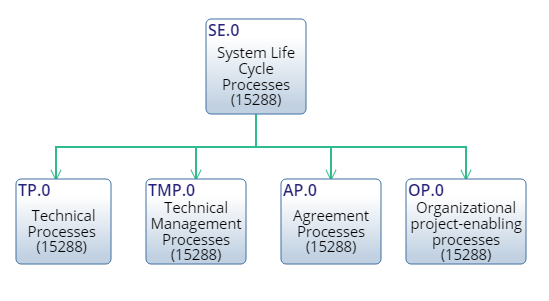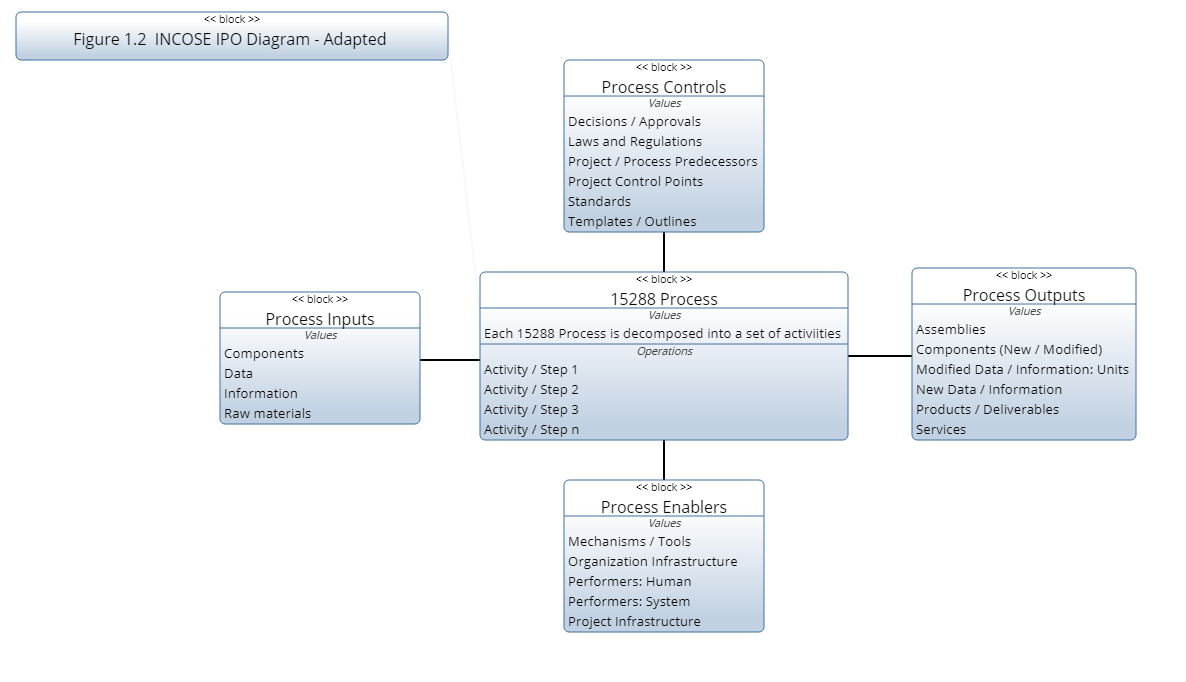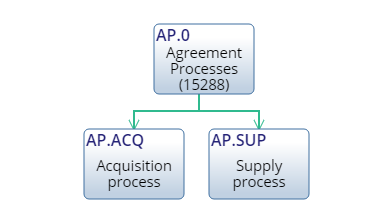Introduction
This article provides introduction and overview of the INCOSE Systems Engineering Handbook; A guide for the systems life cycle processes and activities. As created by the International Council of Systems Engineering and published by John Wiley and Sons. The goal of this article is to establish for the reader awareness of the publication and its contents as a significant source of information on systems engineering.
Citation Information:
INCOSE (2015) Systems Engineering Handbook, A guide to the system lifecycle processes and activities, 4th ed. D.D. Walden, G.J.Roedler, K.J.Forsberg, R.D.Hamelin, and T.M.Shortell (Editors). San Diego, International Council on Systems Engineering. Published by John Wiley and Sons, Inc.
International Council on Systems Engineering (INCOSE) Web Site: www.incose.org
Overview
ISO, IEC and IEEE are international standards bodies that promote the use of standards within their segments. International Standard (ISO/IEC/IEEE 15288:2015) Systems and software engineering - System life cycle processes is published under a joint effort of these organizations. INCOSE is a professional community of practice whose mission is to advance the state of the SE practice through the adoption of common engineering practices and techniques. The purpose of the handbook is to provide a common understanding of the discipline and practice of systems engineering. The intended audience of the standard are those in the practice and leadership of systems engineering as well as those who are students of the practice. This audience may include operations analysts, system architects, engineers, systems developers, computer scientists and project managers (INCOSE 2015). The goal of the SE HAndbook is to expand and amplify the information provided in its normative references.
Normative References:
- ISO/IEC/IEEE 15288:2015 Systems and software engineering - Systems lifecycle processes.
- The Systems Engineering Body of Knowledge (SEBoK 2014) which is also consistent to a large extent with 15288:2015
- ISO/IEC TR 24748-1 Systems and software engineering - Life cycle management.
SE Lexicon
INCOSE adopts the key terms, definitions and abbreviated terms used within the 15288:2015 standard. These terms are also reflected in ISO/IEC/IEEE 24765 Systems and software engineering - Vocabulary available at the SEVOCAB Site. The adaption of a common lexicon for a project is an important best practice recommended my multiple professional organizations. Project team leaders should ensure that the team and the team's products use a common dictionary based on a published source or sources.
CABoK uses the SEVOCAB site as its principle dictionary. In doing so, this body of knowledge is constant with INCOSE 2015, ISO/IEC/IEEE 15288:2015 and ISO/IEC/IEEE 24765.
See Project Communications Best Practices for more information on the selection of a project lexicon and dictionary(s).
Key Topics
SE Processes (Chapter 1)
INCOSE adopts and expands upon the systems engineering processes described in ISO/IEC/IEEE 15288:2015. For the most part, INCOSE does not define new processes, rather it provides amplifying information on the application of the processes defined in 15288 (INCOSE 2015). Figure 1.0 is adopted from INCOSE 2015 and ISO/IEC/IEEE 15288:2015.

The 15288 Agreement Process area is similar to the PMBOK Project Procurement Management Knowledge Area which includes the process areas: Plan Procurement Management, Conducting Procurement and Controlling Procurement knowledge areas within the PMI Project Management Body of Knowledge (PMBoK) (PMI 2017).
The Organizational Process Area area is analogous to the Organizational Process Assets within the PMBoK (PMI 2017).
For more information on SE Processes see CABoK articles on SE Processes
Methods
The INCOSE SE Handbook uses Function models to depict each process along with its inputs, outputs, mechanisms and constraints. The models are consistent with IDEF0 Activity Diagrams and Input/Process/Output (IPO) Models often used in process improvement and leaning methods. This diagramming approach is an effective way of visualizing a process from the top level. Figure 2 represents the Input, Process, Output Model structure used by INCOSE to introduce each process in the handbook (INCOSE 2015).

The block in the center of the diagram represents and activity or function performed in a process. Each activity / function can have one or more Inputs, Outputs, Mechanisms and Constraints.
Inputs are items that are modified or consumed by the activity / function. (Raw material, components, assemblies, data or information)
Outputs are items resulting from the activity / function: new components, assemblies, data or information. Inputs do not normally pass through an activity without being modified.
Controls are items that influence or direct how the activity is to be performed. These directions may be in the form of specifications for developing the outputs, or regulations governing the process. Regulations include safety considerations or environmental policy and design specifications define the structure or characteristics of the output.
Please refer to Activity / Function Models for more information on modeling.
System (Chapter 2)
- Context of a "System"
- Accepted definitions of a "System"
- The elements of a "System"
- The environment in which the system operates.
- The relationships between these elements.
For more on Systems, Systems Context and Systems Environment see System and System Context
Systems Engineering (Chapter 2)
Definition of Systems Engineering
- System Science
- Systems Thinking
- Workforce Development
- SE Value and Effectiveness
System of Systems (Chapter 2)
- Section 2.4 of the Handbook provides an overview of System of Systems.
- Characteristics of an SoS
- Examples of an SoS
- Challenges that influence the SE for and SoS.
For more information on System of Systems see CABoK Articles on SoS
System Life cycle (Chapter 3)
- Generic Life Cycle Stages
- Types of Life Cycles (DoD, NASA, DoE, etc)
- Life Cycle Approaches (Sequential, waterfall, incremental, spiral, etc)
Technical Processes (Chapter 4)

Technical Management Processes (Chapter 5)

Agreement Processes (Chapter 6)

Organizational Project Enabling Processes (Chapter 7)

Specialty Engineering (Chapter 10)
- Affordability/Cost-effectiveness/Life Cycle Cost Analysis
- Electromagnetic Compatibility
- Environmental Engineering
- Interoperability
- Logistics
- Manufacturing and Production Engineering
- Reliability, Maintainability, and Availability Engineering
- Resiliency Engineering
- Safety Engineering
- System Security Engineering
- Human Factors Engineering
- Value Engineering
Cross Cutting Techniques (Chapter 9)
- Modeling and Simulation
- Model Based Systems Engineering
- Function Based Systems Engineering
- Object Oriented Systems Engineering
- Prototyping
- Interface Management
- Integrated Product and Process Development
- Lean Systems Engineering / Lean Methods
- Agile Systems Engineering